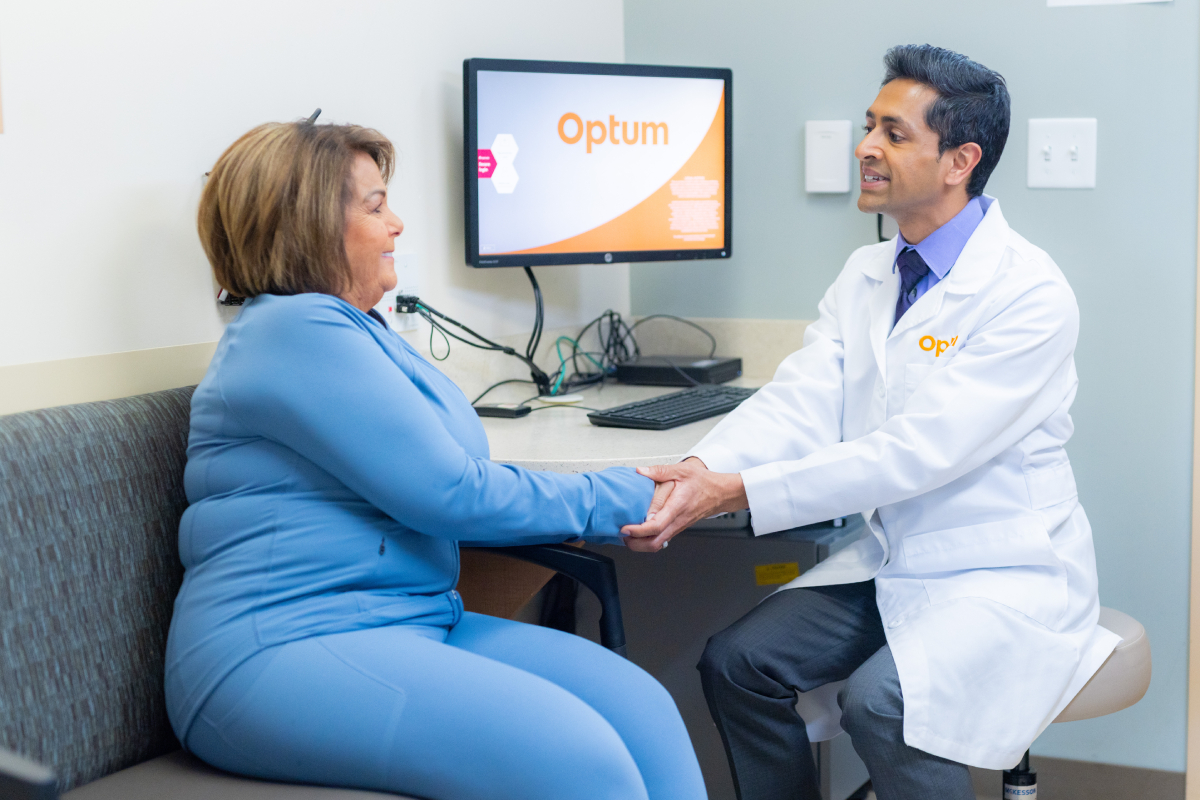
How to have happier feet: Tips for preventing and treating the top causes of foot pain

Aching feet can make it extra hard to do everyday activities. Get relief with advice straight from an Optum doctor.
After a long day, the first thing you’re probably looking for is a spot to rest your tired feet. Simple activities such as cleaning the house or standing in line at the grocery store can cause achy feet in anyone. But certain conditions can make the pain even worse. And they’re more likely to happen as you get older.
“Foot pain can make it a lot harder to get through the day and do the things that we want to do,” says Neil Gokal, MD, a family medicine physician with Optum in Las Vegas. That includes things such as running errands, working out, and going to visit family and friends.
Thankfully, there are many ways to treat and even lower the risk of foot pain as you age. Here are a few common conditions and the best strategies to find relief for your feet.

1. Diabetic foot problems
About 33% of adults ages 65 or older have diabetes.1 And diabetes can cause decreased blood flow and nerve damage in the feet if you have high blood sugar for a long time.2, 3
Symptoms include pain, numbness and tingling. In some people, nerve damage may also reduce the ability to feel pain in the feet. Diabetic foot problems are common, affecting up to half of all people with the disease.4
The best way to prevent nerve damage is to keep blood sugar, as well as your blood pressure and cholesterol, at healthy levels.5 Your Optum doctor can help you find the right levels for you. Your provider may also prescribe medications to help with pain.5
2. Arthritis
Arthritis is inflammation of a joint.6 There are many different types of arthritis. It’s common in the feet and ankles, and can cause pain and stiffness that makes it hard to walk.
Some lifestyle changes may help lower pain. These include:6
- Avoiding activities that make the pain worse
- If you’re overweight, losing weight to lower pressure on your joints
- Trying low-impact exercises such as swimming or cycling that are easier on the feet and ankles
- Wearing shoes or shoe inserts that support your feet
Properly fitting footwear is a great way to help improve arthritis-related foot pain. “Choose shoes that have at least half an inch of space between the tip of your longest toe and the end of the shoe,” says Dr. Gokal. Keep in mind that your heels will want to fit snugly in the shoes. And the shoes should give your toes room to spread comfortably, he adds.
Nonsteroidal anti-inflammatory drugs (NSAIDs) such as ibuprofen and naproxen can also help with swelling and pain.6
3. Gout
Gout is a type of arthritis.7 It causes painful and swollen joints, most often in the big toe. And it often comes as a “flare” that lasts for a week or two.
It can happen suddenly at night and cause serious pain that wakes you up. “Sometimes it’s caused by medications or medical conditions,” says Dr. Gokal. Gout flares can also be triggered by certain foods you eat.
You might get gout if your body has trouble breaking down a chemical called purine.7 This is because purine causes high amounts of uric acid in the body, which can build up and cause gout. Purine is found in foods such as:8
- Certain meats (beef, lamb, venison)
- Organ meats (liver, kidney)
- Some seafood (such as sardines, anchovies, shellfish)
- Certain types of alcohol (beer), including non-alcoholic beer
Your Optum doctor may recommend medications for a flare, including over-the-counter anti-inflammatories.8 There are also prescription medicines such as colchicine and corticosteroids that can relieve symptoms. Taking colchicine when you feel a flare starting can help treat the gout attack.9
You may be able to help lower the chances of a flare by eating foods that are low in purines, says Dr. Gokal. That includes:8
- Fruits and vegetables
- Lean poultry
- Low-fat or non-fat dairy products
- Whole grains
Your Optum Care doctor can help you figure out what’s making your feet hurt and refer you to specialist if needed. Find an Optum doctor.
4. Bunions
A bunion is a bony bump on the inside of the big toe joint.10 These painful growths develop slowly and are usually caused by shoes that are too tight or narrow, says Dr. Gokal. When shoes don’t fit right, they put a lot of pressure on your big toe joint. Over time, the bone and soft tissues actually change position, leading to a bunion.10
A bunion can become painful when your shoes rub against it or when the other toes get crowded.11
The best way to ease the pain? “Wear shoes that have a wider toe box to really relieve the compression at that area of the joint,” Dr. Gokal says. You can also wear silicone pads in your shoes that you place over the bunion. This creates a cushion to protect it.10
5. Heel spur
A heel spur is a small bony growth underneath the heel bone.11 It grows in the spot where the ligament that runs between the ball of your foot and your heel attaches. Heel spurs sometimes develop when that ligament gets inflamed (a condition called plantar fasciitis).12
Heel spurs can also grow after an injury, arthritis or overusing the foot, Dr. Gokal says.
You can help ease any pain by:11, 12
- Icing the bottom of your foot (wrap ice in a towel first)
- Taking an over-the-counter anti-inflammatory medicine
- Wearing shoes that support your arches and cushion the bottom of your foot
“Treating pain with appropriate footwear and padding is a good first step,” Dr. Gokal says. If that doesn’t work, talk with your doctor.
At Optum, our providers know how important it is for you to stay active and pain free as you go about your day. If foot pain is putting a wrench in your plans, talk to your doctor. They can take steps to get you back on your feet again.
Sources
- Endocrine Society. Diabetes and older adults. Last updated January 24, 2022. Accessed January 2, 2024.
- Centers for Disease Control and Prevention. Diabetes and your feet. Last updated April 11, 2023. Accessed January 2, 2024.
- Mayo Clinic. Diabetes care: 10 ways to avoid complications. Last reviewed November 15, 2023. Accessed January 2, 2024.
- National Institute of Diabetes and Digestive and Kidney Diseases. Peripheral neuropathy. Last reviewed February 2018. Accessed January 2, 2024.
- Mayo Clinic. Diabetic neuropathy. Published April 29, 2022. Accessed January 4, 2024.
- American Academy of Orthopaedic Surgeons. Arthritis of the foot and ankle. Last reviewed December 2019. Accessed January 2, 2024.
- National Institute of Arthritis and Musculoskeletal and Skin Diseases. Gout. Last reviewed December 2023. Accessed January 2, 2024.
- National Institute of Arthritis and Musculoskeletal and Skin Diseases. Gout: Diagnosis, treatment, and steps to take. Last reviewed December 2023. Accessed January 2, 2024.
- National Library of Medicine: MedlinePlus. Colchicine. Last revised April 15, 2019. Accessed January 2, 2024.
- American Academy of Orthopaedic Surgeons. Bunions. Last reviewed March 2022. Accessed January 2, 2024.
- Cleveland Clinic. Heel spurs. Last reviewed October 19, 2021. Accessed January 2, 2024.
- American Academy of Orthopaedic Surgeons. Plantar fasciitis and bone spurs. Last reviewed August 2022. Accessed January 2, 2024.
© 2024 Optum, Inc. All rights reserved. Do not reproduce, transmit or modify any information or content on this website in any form or by any means without the express written permission of Optum.
The information featured in this site is general in nature. The site provides health information designed to complement your personal health management. It does not provide medical advice or health services and is not meant to replace professional advice or imply coverage of specific clinical services or products. The inclusion of links to other websites does not imply any endorsement of the material on such websites.
Always read package directions and be sure you understand all directions and precautions before taking any medication. Over-the-counter medications can have side effects, interact with other medications or affect certain medical conditions. Follow your doctor’s advice about medicine use and ask your doctor or pharmacist if you have any questions or concerns.
Do not use ice if you have impaired circulation or impaired sensation.
Stock photo. Posed by model.



